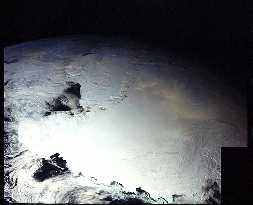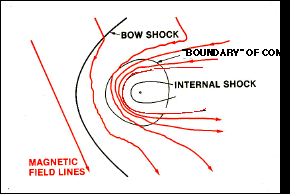This is an image of Antarctica, giving an idea of what an icy surface might look like from space.
Click on image for full size
JPL/NASA
Discovery of Pluto
Pluto is so far away, and has never been explored. Questions to answer about Pluto include the following:
- What are the geologic features of the surface? (pictures of the surface)
- If there are bare spots, what minerals can be found there?
- What is the nature of the atmosphere?
- Are there clouds in the atmosphere?
- What is the character of the winds?
- Is the interior of the planet active?
- What is the temperature of the planet?
and about Charon
- Is there an atmosphere?
- Is there a magnetic field?
Since Pluto's atmosphere should disappear by the year 2000, as it crosses the orbit of Neptune on its 248 year journey around the sun, the time to explore Pluto is now.
You might also be interested in:

The diagram to the left shows what the inside of Pluto may look like. Pluto is mostly made of ice, with a small core of some rocky material buried inside. If the interior is warm enough, the inside of
...more
Of all the planets and moons in the solar system, Pluto and Charon are the two which are the most alike. They are almost the same size, and they are very close together. Pluto and Charon are so close
...more
Pluto is so far away, and has never been explored. Questions to answer about Pluto include the following: What are the geologic features of the surface? (pictures of the surface) If there are bare spots,
...more
It may seem hard to believe that Pluto could have an atmosphere because it is so cold, but it does. Because there are times when Pluto is closer to the sun than is Neptune (making it the 8th planet for
...more
No one knows whether or not Pluto has a magnetosphere. Scientists were very surprised to find that Jupiter's icy moon Ganymede had a magnetosphere because it is hard to explain how an icy body can develop
...more
Pluto has // Call the moon count function defined in the document head print_moon_count('pluto'); moons. One of the moons is very big. The big moon is name Charon. The other two moons are small. They don't
...more
Pluto is a frigid ball of ice and rock that orbits far from the Sun on the frozen fringes of our Solar System. Considered a planet, though a rather odd one, from its discovery in 1930 until 2006, it was
...more













